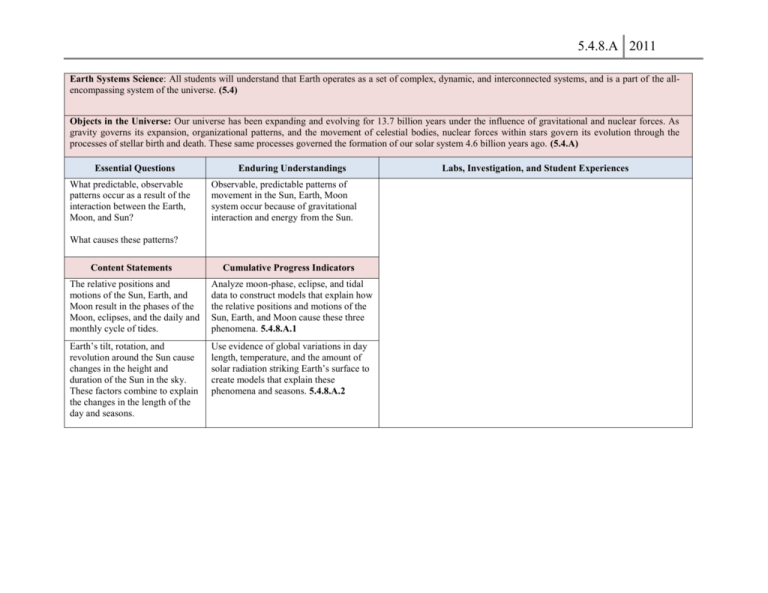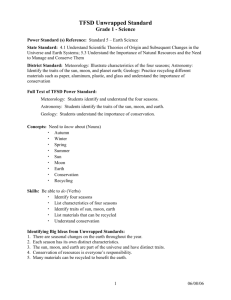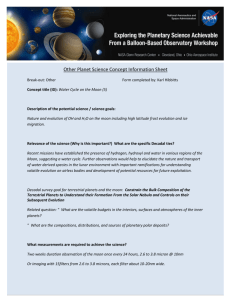A. Objects in the Universe
advertisement

5.4.8.A 2011 Earth Systems Science: All students will understand that Earth operates as a set of complex, dynamic, and interconnected systems, and is a part of the allencompassing system of the universe. (5.4) Objects in the Universe: Our universe has been expanding and evolving for 13.7 billion years under the influence of gravitational and nuclear forces. As gravity governs its expansion, organizational patterns, and the movement of celestial bodies, nuclear forces within stars govern its evolution through the processes of stellar birth and death. These same processes governed the formation of our solar system 4.6 billion years ago. (5.4.A) Essential Questions What predictable, observable patterns occur as a result of the interaction between the Earth, Moon, and Sun? Enduring Understandings Observable, predictable patterns of movement in the Sun, Earth, Moon system occur because of gravitational interaction and energy from the Sun. What causes these patterns? Content Statements Cumulative Progress Indicators The relative positions and motions of the Sun, Earth, and Moon result in the phases of the Moon, eclipses, and the daily and monthly cycle of tides. Analyze moon-phase, eclipse, and tidal data to construct models that explain how the relative positions and motions of the Sun, Earth, and Moon cause these three phenomena. 5.4.8.A.1 Earth’s tilt, rotation, and revolution around the Sun cause changes in the height and duration of the Sun in the sky. These factors combine to explain the changes in the length of the day and seasons. Use evidence of global variations in day length, temperature, and the amount of solar radiation striking Earth’s surface to create models that explain these phenomena and seasons. 5.4.8.A.2 Labs, Investigation, and Student Experiences 5.4.8.A 2011 Gravitation is a universal attractive force by which objects with mass attract one another. The gravitational force between two objects is proportional to their masses and inversely proportional to the square of the distance between the objects. Predict how the gravitational force between two bodies would differ for bodies of different masses or bodies that are different distances apart. 5.4.8.A.3 The regular and predictable motion of objects in the solar system (Kepler’s Laws) is explained by gravitational forces. Analyze data regarding the motion of comets, planets, and moons to find general patterns of orbital motion. 5.4.8.A.4 Desired Results 1. The search for a planet that was causing Uranus to move in unexplained directions led to the discovery of Pluto. Which of the following MOST LIKELY explains why another planet could cause Uranus to move in unexplained directions? A. B. C. D. Uranus has moons with active interiors. Uranus has no atmosphere to change its direction. Another planet could move Uranus with its gravity. Another planet would keep Uranus from drifting away. (MS) 2. Sometimes the Moon looks like a full circle, sometimes it looks like a half circle, and sometimes it looks like a crescent. Explain why the Moon appears to be different shapes at different times. You may use labeled drawings in your explanation. (NAEP) 5.4.8.A 2011 3. It is summer in the Northern Hemisphere when it is winter in the Southern Hemisphere. Which of the following causes this difference in seasons between hemispheres? A. B. C. D. 4. Earth’s axis is tilted in relation to the Sun. The speed of Earth’s rotation on its axis. The curvature of Earth’s surface prevents seasons from occurring simultaneously. The distance from the Sun varies due to Earth’s elliptical orbit. (MS) The diagrams below show the tilt of a planet’s axis relative to a star it is orbiting. This planet has an orbit that is similar to Earth’s. In which diagram does the planet have no seasons? (MS) 5. If you go outside on a sunny day, you will make a shadow. At some times of day your shadow is longer than you are. At other times of day it is shorter than you are. How can this difference in the length of your shadow be explained? (You can use a drawing to help explain your answer.) (NAEP) 6. Suppose that for a science project you wanted to find exactly how much the length of a shadow changes during the day. Describe both the materials and the procedures you would use to make these observations. (NAEP) 5.4.8.A 2011 7. If you measured your shadow at noon during the summer and at noon during the winter, would the measurements be the same or would they be different? (NAEP) 8. Astronauts can jump higher on the Moon than they can on Earth. Which of the following BEST explains why astronauts can jump higher on the Moon? A. B. C. D. 9. The Moon has less mass than Earth. The Moon has more mass than Earth. The Moon’s atmosphere has less oxygen. The Moon’s atmosphere has more oxygen. The dwarf planet Pluto takes much longer to revolve around the Sun than do other planets. This is because Pluto A. B. C. D. is farther from the Sun than other planets. is smaller than other planets. has fewer satellites than other planets. has a very slow rotation as compared to other planets. (ME)









